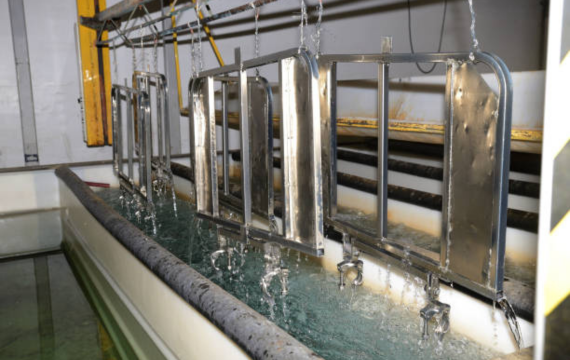Electroplating of titanium involves depositing metal on a substrate of titanium by means of electrochemical techniques.
This technique is adopted particularly to improve the properties of titanium such as corrosion resistance, wear resistance, or aesthetic appearance.
Let’s look at some critical aspects about electroplating titanium:
Benefits of Titanium Electroplating
Titanium electroplating can give you a number of benefits as follows:
- Increased durability: Often coatings can add a level of protection to your products which will increase their useful life or lifetime.
- Enhanced corrosion resistance: Titanium can also be shielded from developing rust under extraordinary conditions by use of coatings.
- Better Aesthetics: Coatings give you a polished and refined look to your products.
- Enhanced heat resistance: Coatings may improve the features of the parts thatyou apply under conditions of high temperature.
- Improved biocompatibility: Coatings can be used to increase the acceptance of medical implants by your body thus increasing biocompatibility.

Properties of Plating on Titanium
You’ll find key properties that enhance titanium plating benefits as given below.
- Corrosion Resistance: Titanium plating offers a great deal of resistance to corrosion, particularly within certain conditions of service.
- Durability: The method enhances the general steadiness of the titanium surface through the exercise of plating.
- Surface Hardness: Coating forms an outer layer that is even harder than the titanium which changes the mechanical properties of the titanium.
- Biocompatibility: Titanium plating remains biocompatible in other tissue and system applications.
- Aesthetic Appeal: Titanium when plated particularly can have shiny and smooth features.
- Adhesion: A plated layer mechanically fastens itself to the titanium, thus there is a metal-to-metal bond.
- Conductivity: Plating can thus affect the surface’s electrical conductivity of the titanium.
- Wear Resistance: It also becomes more resistant to wear and tear which is as a result of mechanical action.
- Lubricity: The plated surface also includes lesser of friction, meaning that the surface has easy mobility.
- High Strength, Low Weight: The plating retains Titanium properties of being both strong and at the same time very light.
Methods of Titanium Electroplating
Now it is the time to look through some methods of titanium electroplating:
- Electroless Nickel Plating: This chemical process assists in enhancing adhesion and also increases corrosion resistance of this product. Plate titanium with a layer of nickel or copper without the application of electric current.
- Pulse Plating: For better control of the deposition and minimization of porosity, one should try using pulsed current to enhance the quality of the coating.
- Vacuum Deposition (PVD/CVD): To make smooth and even layers with a strong bond, evaporate metal and then put it onto titanium in a vacuum environment.
- Plasma-Enhanced Chemical Vapor Deposition (PECVD): If a closer regulation of the characteristics of the coat is desired, then you should employ plasma. This is to break gases and deposit a metal layer onto titanium.
- Ion Plating: As a result of dense adherent coatings with corrosion as well as wear protection properties, enhance ions of the wanted metal and alleviate them onto titanium.
- Molten Salt Electroplating: The process allows for achieving thick, uniform coatings with good adhesion properties and high corrosion resistance. This is by plate titanium in a molten salt bath.
- Cathodic Arc Deposition: For the formation of dense and adherent coatings with attractive mechanical characteristics; apply a high current arc to vaporize material and then deposit it onto titanium.
Challenges in Titanium Electroplating
There are several issues likely to arise if you are electroplating titanium; the following are some of them.
- Oxide Layer Formation: Titanium is known to form a passive oxide layer that can resist metal adhesion. This layer you have to take it off or change before you start the plating process.
- Electrolyte Compatibility: Choosing the right electrolytes that can nicely deposit metals on titanium may be a challenging task because titanium is highly reactive.
- Adhesion Issues: Achieving excellent bonding between the plated metal and titanium can be a difficult thing, especially in relation to the oxide layer.
- Uniformity: It may be difficult to have the coatings uniform on the difficult shapes of titanium especially the current distribution of titanium may not be even.
- Cost: Titanium electroplating is however more costly than plating of other metals because of the special practice involved in the process.
- Hydrogen Embrittlement: Remember that electroplating also involves hydrogenation of the titanium and this has the effects of making the metal brittle, weaker, and less ductile.

Alternatives to Titanium Electroplating
Due to the challenges that are associated with electroplating of titanium, you will need to use other forms of coatings most of the time:
· Anodizing:
Applied to grow a denser layer of the natural titanium oxide layer. This increases corrosion protection and provides other ways of putting colors.
· Titanium Nitride Coating:
This process converts them into very thin layers of titanium nitride (TiN). This forms a hard and wear resistance layer coat which is ideal for the formation of cutting tools as well as biomedical applications.

Applications of Titanium Electroplating
Titanium electroplating is versatile. It is being employed, more or less, in a number of industries. Here is how you can use it.
- Aerospace:
Improve the anti-corrosive qualities, durability, and high-temperature stability of your aircraft by applying titanium coatings to protect and improve the performance of your aircraft.
- Medical Devices:
Coat to make the implant more biocompatible, to give a smooth surface which reduces chances of corrosion and to improve both utility and aesthetics.
- Automotive:
Use coatings to improve the corrosion and wear properties, meaning your automotive parts will have longer service and be far more effective.
- Marine Applications:
Employ coatings to shield marine parts and assemblies from rust and the influence of saltwater for the purpose of enhancing durability and reliability.
- Electronics:
Select coatings for conductivity and to avoid corrosion and increase the lifespan of your electronics to enhance performance.
FAQs
1. Why Is It Difficult to Plate onto Titanium?
Plating titanium is tough. It is composed of an oxide layer that prevents adhesion.
Titanium is not friendly with electrolytes; it is difficult to come across a suitable electrolyte. Hydrogen absorption makes the material brittle and the process is not easy technically.
2. Is it possible to Electroplate with Titanium?
Yes, but it is not easy because titanium has an oxide layer and it is very reactive.
3. Can Titanium be Electroplated onto Stainless Steel?
Yes, so long as in between layers, such as nickel or copper, are intervening to enhance the adhesion.
4. Can Titanium be used for Electroplating?
Yes, but such a process involves specific methods because of the nature of titanium.
5. How Strong is Titanium Plating?
Titanium plating is very robust and therefore has great endurance to abrasion and wear.
6. Can Titanium be Nickel Plated?
Yes, you can do a nickel plating on titanium although it is mostly used as the middle layer.
7. Is Titanium Plating Good?
Yes, titanium platingis totally good. It can be used for corrosion resistance and the general improvement of the ‘hardness’ of the material as well as biocompatibility.
8. Which is Better Titanium or Steel Plate?
Titanium is superior in corrosion and weight consideration but steel is better in cost and abundance.
Conclusion
Nevertheless, Titanium electroplating is sensitive and has to undergo special methods owing to its reactivity and oxide.
Electroless plating, molten salt, and vapor deposition give high-quality coatings for aerospace, medical, and electronic industries requiring corrosion protection for their products.
More resources:
Electroplating Process – Source: WIKIPEDIA
Titanium Alloy Types – Source: KDM
Welding Titanium – Source: KDM
Titanium Hydroforming – Source: KDM




